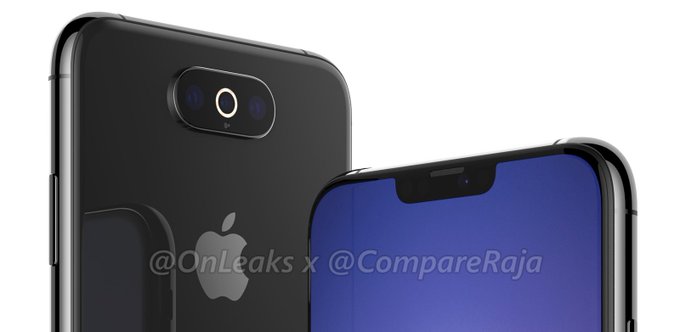As Samsung leads the market toward 5G and foldable screens, can Apple keep up?

We probably won’t see Apple’s next iPhone — possibly called the iPhone 11 — until this fall, but 2019 is already a dramatic, game-changing year for phones.
We’re at the dawn of 5G, the next generation of cellular technology, which promises to increase connectivity speeds by an order of magnitude (or two). The first phones with foldable displays have been announced and will launch later this year. And we’re already seeing phones with incredibly advanced camera technology on store shelves — five lenses! 48 megapixels! — with even higher-resolution imaging on the way.

And, as far as we know, the next generation iPhone will have none of it.
With all of the biggest players set to debut 5G phones in 2019, the signals suggest that Apple won’t join them until 2020 — at the earliest. With the company still working to bring OLED displays to the entirety of its lineup, foldable screens don’t seem to be a realistic route on Apple’s near-term roadmap — interesting patents, notwithstanding. There are some rumors about laser-guided, AR-ready, 3D cameras being integrated with Face ID in the future, but the consensus is that we’ll see only incremental steps for Apple’s camera technology in the next iPhone.

But, still, this is Apple. Despite signs of slumping performance at the end of 2018, it still made $37 billion in revenue from selling nearly 50 million phones from July through September last year. The iPhone remains a premium product sold by a premium brand. So we can’t count out the possibility of Apple surprising us this fall with revolutionary features or distinctive aesthetics.
In the meantime, there’s no shortage of analysts, pundits and leakers guessing at those features and aesthetics. And one miniature scandal has already blown through the iPhone 11 rumor mill. On Jan. 10, prominent leaker Ben Geskin tweeted his personal wishlist of features for the next-generation iPhone, which included a ProMotion Display, triple camera array, 4,000-mAh battery and wireless charging. The tweet, transmogrified by the internet, became the source of a handful of articles about potential specs for the forthcoming iPhone 11. Eventually, the misunderstanding was cleared up, corrections were made, and we went back into the dark, mostly empty abyss of known facts about the next iPhone.
Rumor: Deja vu all over again, with three new iPhones expected in September 2019

Apple plans to stick to the script from recent years, introducing three new iPhone models this fall, according to the Wall Street Journal. We expect the new models to generally follow the format of the current generation: a “budget” successor to the iPhone XR, a midrange flagship following in the footsteps of the iPhone XS and a supersized model like the iPhone XS Max.

And what will Apple call this next batch of phones? As my colleague Jessica Dolcourt has pointed out, Apple may have dug itself into a hole with the current crop. There’s no obvious sequel to the iPhone XS, XS Max and XR. So far, most of the reports we’ve seen use the iPhone 11 or iPhone XI nomenclature.
Likely: The 2019 iPhone won’t support 5G
The upcoming launch of 5G later this year will mark a significant step forward for the telecommunications industry. But it’s looking like Apple will stay on the sidelines, at least this year.
CNET’s Shara Tibken has reported that the company’s shift to 5G may have been slowed by its licensing dispute with Qualcomm, which makes the modem that will power the first wave of 5G phones, slated to arrive in the next few months. Bloomberg reports that Apple will not release a 5G phone until 2020.

The back story: After years as a Qualcomm customer, Apple dumped the company in 2018 over a legal dispute. Its most recent batch of phones — the iPhone XS, XS Max and XR — all use modems built by Intel, whose 5G modem will be ready for commercial devices in the second half of 2019, with broader deployment set for 2020.
That noted, the FTC’s ongoing lawsuit against Qualcomm is unearthing hints about the company’s relationship with Apple as well as forthcoming products. During the proceedings, an Apple supply chain executive testified that the company considered using modems made by MediaTek and Samsung for the iPhones coming in 2019, as reported by Reuters. But the executive stopped short of disclosing whether Apple had selected a 5G modem supplier or would actually release a 5G iPhone this year.

OnLeaks/Digit
Cameras have always been a major focus of iPhone rumors, and the early consensus suggests that one or more of this year’s phones will have three rear-facing lenses. Bloomberg has now published an article suggesting that at least one of the 2019 iPhones will have three cameras on the back. (The article also suggests that a subsequent iOS update will double the length of Live Photos to six seconds.)
Bloomberg’s reporting follows an earlier leak from Twitter user Ice Universe, who posted a render of what’s purported to be a prototype of the new array, made up of three cameras in a triangular configuration, plus a flash, housed in a large, square-shaped module. (Ice Universe later tweeted that such a camera design is an “irreversible reality.”)
An article published by OnLeaks and Indian site CompareRaja posits an alternative theory, however: The iPhone 11 will have three rear-facing cameras, including 10- and 14-megapixel sensors, with two of the lenses and the flash positioned encircling one central lens. As shown in the renders, it looks somewhat like the camera on the back of the Huawei Mate 20 Pro — but centered, giving the phone something of a cyclops look. Assuming that there would also be at least one camera on the front of such a device, the next generation iPhone could have four (or more) cameras in total.
Rumor: The iPhone 11’s battery will be able to charge other devices

Samsung
A note from veteran Apple analyst Ming-Chi Kuo says that the next generation iPhone will support bilateral charging, as reported by 9to5Mac. That means you’ll be able to use your iPhone’s battery to charge other devices. Even if it’s true, Apple will again be playing catchup to Samsung, whose newest Galaxy S10 phones can charge other devices — including the company’s Galaxy Buds and Galaxy Watch Active — via the wireless Qi standard.
In addition, Kuo has predicted that all of the new 2019 iPhones will have larger batteries — and, presumably, even better battery life. And that’s saying something: on our video playback battery drain test, the iPhone XR lasted for more than 19 hours and the iPhone XS Max held out for over 17 hours, 23 minutes, while the iPhone XS stayed alive for only 13 hours, 30 minutes.

PhoneArena
With a dearth of official news, and even of credible leaks, we’re left to sort through the renders — the output of imaginative minds with advanced Photoshop skills. Currently making the rounds are mocked-up photos showing what iOS 13 — that’s ostensibly what Apple will call the next version of its mobile operating system — on the forthcoming iPhone 11 could look like in “dark mode,” courtesy of PhoneArena. In the images, the iPhone 11 seems to be based on a variation of the “cyclops” design, featured above.
Rumor: The iPhone goes to USB-C in 2019
One of the longest-standing iPhone rumors concerns Apple making the jump to USB-C. This year, however, there’s more momentum behind the buzz, as the company has now replaced its proprietary Lightning connector with USB-C on the newest iPad Pros, MacBook Air and MacBook Pros.
Bloomberg now says that Apple is “testing” USB-C on some prototype iPhones, following previous reporting by Mac Otakara that suggested that the company was considering making the switch on the next-generation model. The video embedded below, published by ConceptsiPhone, shows what an iPhone with a USB-C connection could look like.
Steve Hemmerstoffer, who runs the OnLeaks Twitter account, says that the 2019 iPhone prototype he’s seen features a Lightning port for charging — not a USB-C connection, according to CompareRaja.com.
Rumor: Apple sticks with LCD and OLED mix
Among the three phones Apple released in 2018, only the iPhone XR has an LCD display. The two higher-end models, the iPhone XS and XS Max, both use OLED panels that have higher resolutions and produce more vivid colors and images.
Though Apple could feasibly adopt OLED technology across its phone portfolio this year — bringing the more expensive panel to whatever follows the XR, in addition to the sequels to the XS and XS Max — that’s more likely to happen in 2020, according to the Wall Street Journal. (So far, we’ve heard precisely zero credible rumors about plans for a foldable iPhone.)
Rumor: Apple will upgrade Face ID

Bloomberg’s report says that Apple’s forthcoming 3D camera — which may not be included on any 2019 phone — will drive an updated version of Face ID, that will extend the technology’s range, improve security and enable new AR capabilities.
Previously, Apple analyst Ming-Chi Kuo (via MacRumors) predicted a much more modest update for Face ID in 2019 — the addition of a new “flood illuminator” to all forthcoming iPhones, which will mitigate environmental light and improve Face ID performance. In other words, the next version of Face ID may include a brighter light that will help the phone recognize you faster and more accurately, with more dramatic advancements coming in 2020 and beyond.
Rumor: New A13 processor powers the iPhone 11

The A12 Bionic chip that powers the newest iPhones is crazy powerful. According to analyst Ben Thompson, the processor is “so far ahead of the industry that it will still be competitive with the best Android phones in two years, and massively more powerful than lower-end phones.” That means that Apple doesn’t necessarily have to put a new chip in the next generation of iPhones to stay competitive — but it almost certainly will. This could be the A12X processor that’s currently used in the newest iPad Pros — or a new chip, ostensibly called the A13.
Rumor: iPhone apps coming to the Mac (and vice-versa)

Sarah Tew/CNET
In addition to unveiling a new version of its A-series chips for the next iPhone, Apple is said to be planning a major processor shift for its computers. Starting in 2020, the company will stop using Intel chips in its Macs in favor of custom ARM-based processors. This will let developers create a single version of their apps — starting sometime in 2021 — that’ll work across Apple’s various operating systems on the iPhone, iPad and Mac, according to Bloomberg and Axios.
Rumor: iPhone prices will increase again in 2019
When Apple announced a $1,000 price tag for the iPhone X in 2017, critics complained. But customers didn’t seem to care, and the phone outsold every other Apple device for weeks thereafter.
Apple took note, and the iPhone XS and XS Max ratcheted prices up even higher, starting at $999 and $1,099 respectively. My colleague Jessica Dolcourt’s analysis shows a pattern of hefty price increases in the premium smartphone market over the past two years, and we expect Apple, Samsung — which just announced a foldable phone that costs nearly $2,000 — and others to continue pushing the boundaries of customer budgets for the foreseeable future.












































